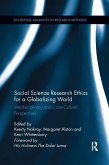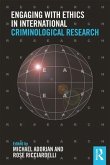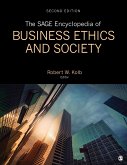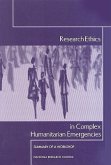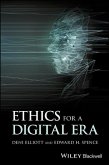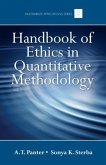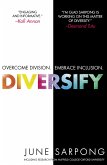- Broschiertes Buch
- Merkliste
- Auf die Merkliste
- Bewerten Bewerten
- Teilen
- Produkt teilen
- Produkterinnerung
- Produkterinnerung
Van den Hoonaard reveals an idiosyncratic and inconsistent world in which researchers employ particular strategies of avoidance or partial or full compliance as they seek approval from ethics committees.
Andere Kunden interessierten sich auch für
![Social Science Research Ethics for a Globalizing World Social Science Research Ethics for a Globalizing World]() Social Science Research Ethics for a Globalizing World67,99 €
Social Science Research Ethics for a Globalizing World67,99 €![Engaging with Ethics in International Criminological Research Engaging with Ethics in International Criminological Research]() Engaging with Ethics in International Criminological Research74,99 €
Engaging with Ethics in International Criminological Research74,99 €![The Sage Encyclopedia of Business Ethics and Society The Sage Encyclopedia of Business Ethics and Society]() The Sage Encyclopedia of Business Ethics and Society1.478,99 €
The Sage Encyclopedia of Business Ethics and Society1.478,99 €![Research Ethics in Complex Humanitarian Emergencies Research Ethics in Complex Humanitarian Emergencies]() National Research CouncilResearch Ethics in Complex Humanitarian Emergencies25,99 €
National Research CouncilResearch Ethics in Complex Humanitarian Emergencies25,99 €![Ethics for a Digital Era Ethics for a Digital Era]() Deni ElliottEthics for a Digital Era45,99 €
Deni ElliottEthics for a Digital Era45,99 €![Handbook of Ethics in Quantitative Methodology Handbook of Ethics in Quantitative Methodology]() Handbook of Ethics in Quantitative Methodology109,99 €
Handbook of Ethics in Quantitative Methodology109,99 €![Diversify Diversify]() June SarpongDiversify16,99 €
June SarpongDiversify16,99 €-
-
-
Van den Hoonaard reveals an idiosyncratic and inconsistent world in which researchers employ particular strategies of avoidance or partial or full compliance as they seek approval from ethics committees.
Hinweis: Dieser Artikel kann nur an eine deutsche Lieferadresse ausgeliefert werden.
Hinweis: Dieser Artikel kann nur an eine deutsche Lieferadresse ausgeliefert werden.
Produktdetails
- Produktdetails
- Verlag: University of Toronto Press
- Seitenzahl: 392
- Erscheinungstermin: 13. Juni 2011
- Englisch
- Abmessung: 226mm x 150mm x 25mm
- Gewicht: 590g
- ISBN-13: 9781442611504
- ISBN-10: 1442611502
- Artikelnr.: 33767871
- Herstellerkennzeichnung
- Produktsicherheitsverantwortliche/r
- Europaallee 1
- 36244 Bad Hersfeld
- gpsr@libri.de
- Verlag: University of Toronto Press
- Seitenzahl: 392
- Erscheinungstermin: 13. Juni 2011
- Englisch
- Abmessung: 226mm x 150mm x 25mm
- Gewicht: 590g
- ISBN-13: 9781442611504
- ISBN-10: 1442611502
- Artikelnr.: 33767871
- Herstellerkennzeichnung
- Produktsicherheitsverantwortliche/r
- Europaallee 1
- 36244 Bad Hersfeld
- gpsr@libri.de
Will C. van den Hoonaard is a professor emeritus in the Department of Sociology at the University of New Brunswick.
Preface
Acknowledgments
Figures and Tables
1. INTRODUCTION
Premise of The Seduction of Ethics
Ignorance and Scholarship
The Scholarship on the Metabolism of Research-Ethics Review
Conceptual Scheme
Research Methods
Outline of The Seduction of Ethics
2. AN ARCHEOLOGY OF RESEARCH-ETHICS REVIEW
Outside the Ethics Regime: What Drives the System of Ethics Review?
Inside the System: Institutionalization of Research-Ethics Review
3. THE CRITICISMS OF RESEARCH-ETHICS REVIEW
Does the Ethics Regime Offer an Inappropriate Model for Social
Science Research?
Is Research Ethics Strangling Legitimate Research?
Does Ethics Review Curtail Academic Freedom?
Are Ethics Committees Bureaucracies?
Does Ethics Review Develop and Maintain the Hegemony of Ethics
Committees?
Attempts to Negotiate the Two Worlds and Transcend the Criticisms:
The Perspectives of Ethics Committees
4. WHAT IS THE NORMATIVE ETHICS FRAMEWORK FOR SOCIAL RESEARCHERS?
The ‘Subject’ in International and National Research-Ethics Codes
Bursting the Contemporary Ethics Bubble: Three Case Studies
5. STRUCTURE AND COMPOSITION OF RESEARCH-ETHICS COMMITTEES
Ethics Committees as Part of the University
Membership
Jurisdictional Power and Independence
Workload
6. THE MORAL COSMOLOGY OF THE ETHICS-REVIEW WORLD
About Themselves
About Researchers
About Research Participants
7. PROCEDURAL ROUTINES: THE APPLICATION FORM AND THE CONSENT FORM
The Application Form
The Consent Form
8. THE MEETING: MAKING AGENDAS AND DECISIONS
Attendance and Membership
The Career of the Agenda
Paradigms and Perspectives that Shape the Conversation about Ethics
Making Decisions without Principles
9. AN IDIOSYNCRATIC AND INCONSISTENTWORLD: COMMUNICATIONS BETWEEN REBS
AND RESEARCHERS
Interpretation as the Basis of Idiosyncrasies and Inconsistencies
Communications to Researchers/Language of (Dis)approval
Content
Language
REB Communications inside the Larger Context of the Ethics Regime
10. THE UNDERLIFE OF RESEARCH-ETHICS REVIEW: PREPARING AN APPLICATION
The ‘Hurt Perspective’
The Researcher’s Moral Career
Warming up (or Not) to Submitting the Proposal
Preparing for the ‘News’
11. SECONDARY ADJUSTMENTS BY RESEARCHERS
Reactions by Researchers to Ethics Reviews
Applying Secondary Adjustments
The Social Situation of Students in the Ethics-Review Process
12. THE BELEAGUERED METHODS
General Considerations about Redirecting Research
The Declining Use of Particular Methods
13. ON THEORY, TOPICS, AND FAVOURED METHODS
Acknowledgments
Figures and Tables
1. INTRODUCTION
Premise of The Seduction of Ethics
Ignorance and Scholarship
The Scholarship on the Metabolism of Research-Ethics Review
Conceptual Scheme
Research Methods
Outline of The Seduction of Ethics
2. AN ARCHEOLOGY OF RESEARCH-ETHICS REVIEW
Outside the Ethics Regime: What Drives the System of Ethics Review?
Inside the System: Institutionalization of Research-Ethics Review
3. THE CRITICISMS OF RESEARCH-ETHICS REVIEW
Does the Ethics Regime Offer an Inappropriate Model for Social
Science Research?
Is Research Ethics Strangling Legitimate Research?
Does Ethics Review Curtail Academic Freedom?
Are Ethics Committees Bureaucracies?
Does Ethics Review Develop and Maintain the Hegemony of Ethics
Committees?
Attempts to Negotiate the Two Worlds and Transcend the Criticisms:
The Perspectives of Ethics Committees
4. WHAT IS THE NORMATIVE ETHICS FRAMEWORK FOR SOCIAL RESEARCHERS?
The ‘Subject’ in International and National Research-Ethics Codes
Bursting the Contemporary Ethics Bubble: Three Case Studies
5. STRUCTURE AND COMPOSITION OF RESEARCH-ETHICS COMMITTEES
Ethics Committees as Part of the University
Membership
Jurisdictional Power and Independence
Workload
6. THE MORAL COSMOLOGY OF THE ETHICS-REVIEW WORLD
About Themselves
About Researchers
About Research Participants
7. PROCEDURAL ROUTINES: THE APPLICATION FORM AND THE CONSENT FORM
The Application Form
The Consent Form
8. THE MEETING: MAKING AGENDAS AND DECISIONS
Attendance and Membership
The Career of the Agenda
Paradigms and Perspectives that Shape the Conversation about Ethics
Making Decisions without Principles
9. AN IDIOSYNCRATIC AND INCONSISTENTWORLD: COMMUNICATIONS BETWEEN REBS
AND RESEARCHERS
Interpretation as the Basis of Idiosyncrasies and Inconsistencies
Communications to Researchers/Language of (Dis)approval
Content
Language
REB Communications inside the Larger Context of the Ethics Regime
10. THE UNDERLIFE OF RESEARCH-ETHICS REVIEW: PREPARING AN APPLICATION
The ‘Hurt Perspective’
The Researcher’s Moral Career
Warming up (or Not) to Submitting the Proposal
Preparing for the ‘News’
11. SECONDARY ADJUSTMENTS BY RESEARCHERS
Reactions by Researchers to Ethics Reviews
Applying Secondary Adjustments
The Social Situation of Students in the Ethics-Review Process
12. THE BELEAGUERED METHODS
General Considerations about Redirecting Research
The Declining Use of Particular Methods
13. ON THEORY, TOPICS, AND FAVOURED METHODS
Preface
Acknowledgments
Figures and Tables
1. INTRODUCTION
Premise of The Seduction of Ethics
Ignorance and Scholarship
The Scholarship on the Metabolism of Research-Ethics Review
Conceptual Scheme
Research Methods
Outline of The Seduction of Ethics
2. AN ARCHEOLOGY OF RESEARCH-ETHICS REVIEW
Outside the Ethics Regime: What Drives the System of Ethics Review?
Inside the System: Institutionalization of Research-Ethics Review
3. THE CRITICISMS OF RESEARCH-ETHICS REVIEW
Does the Ethics Regime Offer an Inappropriate Model for Social
Science Research?
Is Research Ethics Strangling Legitimate Research?
Does Ethics Review Curtail Academic Freedom?
Are Ethics Committees Bureaucracies?
Does Ethics Review Develop and Maintain the Hegemony of Ethics
Committees?
Attempts to Negotiate the Two Worlds and Transcend the Criticisms:
The Perspectives of Ethics Committees
4. WHAT IS THE NORMATIVE ETHICS FRAMEWORK FOR SOCIAL RESEARCHERS?
The ‘Subject’ in International and National Research-Ethics Codes
Bursting the Contemporary Ethics Bubble: Three Case Studies
5. STRUCTURE AND COMPOSITION OF RESEARCH-ETHICS COMMITTEES
Ethics Committees as Part of the University
Membership
Jurisdictional Power and Independence
Workload
6. THE MORAL COSMOLOGY OF THE ETHICS-REVIEW WORLD
About Themselves
About Researchers
About Research Participants
7. PROCEDURAL ROUTINES: THE APPLICATION FORM AND THE CONSENT FORM
The Application Form
The Consent Form
8. THE MEETING: MAKING AGENDAS AND DECISIONS
Attendance and Membership
The Career of the Agenda
Paradigms and Perspectives that Shape the Conversation about Ethics
Making Decisions without Principles
9. AN IDIOSYNCRATIC AND INCONSISTENTWORLD: COMMUNICATIONS BETWEEN REBS
AND RESEARCHERS
Interpretation as the Basis of Idiosyncrasies and Inconsistencies
Communications to Researchers/Language of (Dis)approval
Content
Language
REB Communications inside the Larger Context of the Ethics Regime
10. THE UNDERLIFE OF RESEARCH-ETHICS REVIEW: PREPARING AN APPLICATION
The ‘Hurt Perspective’
The Researcher’s Moral Career
Warming up (or Not) to Submitting the Proposal
Preparing for the ‘News’
11. SECONDARY ADJUSTMENTS BY RESEARCHERS
Reactions by Researchers to Ethics Reviews
Applying Secondary Adjustments
The Social Situation of Students in the Ethics-Review Process
12. THE BELEAGUERED METHODS
General Considerations about Redirecting Research
The Declining Use of Particular Methods
13. ON THEORY, TOPICS, AND FAVOURED METHODS
Acknowledgments
Figures and Tables
1. INTRODUCTION
Premise of The Seduction of Ethics
Ignorance and Scholarship
The Scholarship on the Metabolism of Research-Ethics Review
Conceptual Scheme
Research Methods
Outline of The Seduction of Ethics
2. AN ARCHEOLOGY OF RESEARCH-ETHICS REVIEW
Outside the Ethics Regime: What Drives the System of Ethics Review?
Inside the System: Institutionalization of Research-Ethics Review
3. THE CRITICISMS OF RESEARCH-ETHICS REVIEW
Does the Ethics Regime Offer an Inappropriate Model for Social
Science Research?
Is Research Ethics Strangling Legitimate Research?
Does Ethics Review Curtail Academic Freedom?
Are Ethics Committees Bureaucracies?
Does Ethics Review Develop and Maintain the Hegemony of Ethics
Committees?
Attempts to Negotiate the Two Worlds and Transcend the Criticisms:
The Perspectives of Ethics Committees
4. WHAT IS THE NORMATIVE ETHICS FRAMEWORK FOR SOCIAL RESEARCHERS?
The ‘Subject’ in International and National Research-Ethics Codes
Bursting the Contemporary Ethics Bubble: Three Case Studies
5. STRUCTURE AND COMPOSITION OF RESEARCH-ETHICS COMMITTEES
Ethics Committees as Part of the University
Membership
Jurisdictional Power and Independence
Workload
6. THE MORAL COSMOLOGY OF THE ETHICS-REVIEW WORLD
About Themselves
About Researchers
About Research Participants
7. PROCEDURAL ROUTINES: THE APPLICATION FORM AND THE CONSENT FORM
The Application Form
The Consent Form
8. THE MEETING: MAKING AGENDAS AND DECISIONS
Attendance and Membership
The Career of the Agenda
Paradigms and Perspectives that Shape the Conversation about Ethics
Making Decisions without Principles
9. AN IDIOSYNCRATIC AND INCONSISTENTWORLD: COMMUNICATIONS BETWEEN REBS
AND RESEARCHERS
Interpretation as the Basis of Idiosyncrasies and Inconsistencies
Communications to Researchers/Language of (Dis)approval
Content
Language
REB Communications inside the Larger Context of the Ethics Regime
10. THE UNDERLIFE OF RESEARCH-ETHICS REVIEW: PREPARING AN APPLICATION
The ‘Hurt Perspective’
The Researcher’s Moral Career
Warming up (or Not) to Submitting the Proposal
Preparing for the ‘News’
11. SECONDARY ADJUSTMENTS BY RESEARCHERS
Reactions by Researchers to Ethics Reviews
Applying Secondary Adjustments
The Social Situation of Students in the Ethics-Review Process
12. THE BELEAGUERED METHODS
General Considerations about Redirecting Research
The Declining Use of Particular Methods
13. ON THEORY, TOPICS, AND FAVOURED METHODS


